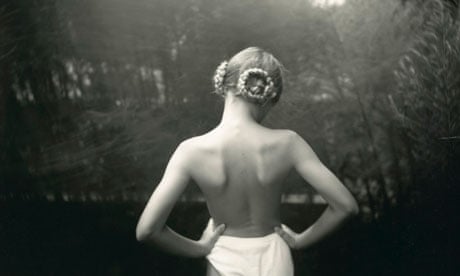Sally Mann is perhaps best known for the controversy that attended her series Immediate Family when it was first exhibited in America in the early 90s. It featured black and white images of her three children, often naked or partially naked, as they played and posed in the woods, lakes and rivers around her home in rural Virginia.
The images, some of which are on show here in the 59-year-old American's first British retrospective, are by turns beautiful, disturbing and unashamedly sensual. Perhaps more problematically, all of them are, to one degree or another, staged. One photograph that is not on show here features her son's torso stained with a blood-like liquid that has dripped from his abdomen to his upper thighs. It is called "Popsicle Drips", a title that undercuts the potentially worrying nature of the liquid smear, but does little to dispel the lingering sense of provocation.
"Many of these pictures are intimate, some fictions and some fantastic," Mann said of the series, "but most are ordinary things that every mother has seen." Well, maybe, but not every mother has restaged and then rendered them in such a darkly beautiful and ambiguous ways. Intriguingly, none of the more outrightly provocative photographs have found their way into this show, which is an edited version of a bigger retrospective exhibition that has already toured Europe. Whether this is down to lack of space or fear of public – or tabloid – outcry is anyone's guess, but one could argue that something has been lost in this excised version of the series: the sense that Mann is walking a tightrope between reflecting childhood sexuality in all its lack of self-consciousness and staging it in often dramatic reconstructions. This, in effect, is where the true power of her art lies.
The photographs of her children are undeniably beautiful in their depth, detail and composition. Taken over a 10-year period on a large format 8x10-inch camera, they make her Virginian backwoods look idyllic in the manner of Victorian landscape prints. Except, that is, for the more surrealist images: one called "The Alligator's Approach" has her youngest daughter sleeping by the banks of a river while the predator of the title appears at the water's edge. Her daughter is, of course, pretending to sleep and the alligator is an inflatable toy, but nonetheless the photograph exudes a palpable sense of unease.
Even more so an image entitled simply and directly "The Terrible Picture", in which one of her young daughters appears to be hanging by the neck from a tree. Death stalks this vision of a childhood idyll as it does all Mann's photographs, and, ever the artistic provocateur, she seems to summon its presence perhaps as a way of making it less real and threatening to herself. (One of the great things about her work is the way it brings out the amateur psychologist in the viewer.)
The other, even more disturbing series on show here is entitled What Remains (2000–04), which approaches death and dying head on. Mann gained access to the University of Tennessee Forensic Anthropology Centre, a place that would not seem out of place in one of Chuck Palahniuk's darkly humorous short stories. Here, bodies that have been donated to science are left outside in the woods so that the process of organic decomposition can be studied by forensic scientists.
Mann's close-up images of these rotting corpses are not for the faint of heart, but, again, the prints – made by an old-fashioned chemical method called the wet-plate collodion process – have a Victorian feel that is almost painterly. One does, though, feel like a voyeur when looking at images such as this. They raise the ethical question of whether a person's decision to donate their body to science gives scientists the right, at a later date, to grant Mann permission to photograph that – decomposing – body. (And whether the result should then be displayed as art. )
Over the years, the process of making photographs has become central to Mann's work. Her use of old, often unwieldy, plate cameras and old printing techniques is arduous in the extreme but reflects the patience and rigour she undoubtedly applies to her interlinked subject matter. Her landscapes are pure southern gothic – to the point where you can picture them on the cover of a Penguin Classics reprint of a Faulkner novel. She captures unreal places where time seems to have stood still since the civil war: overgrown gardens, humid swamplands and dappled creeks that have somehow resisted the thrust of modernity.
In these images, as with her close-up portraits of her children's faces, the surface of the photograph is often dappled too – with drips, stains, dust motes. Again, the wet-plate collodion process comes into play, and one can see why it has sometimes been called "painting in light". Mann often prints her images in the back of her truck, where dust and humidity do their work, often preventing the chemicals from adhering properly to the glass. All the resulting imperfections add to the sense of history and decay that, increasingly, seems to be her abiding fascination.
The philosopher Roland Barthes once admitted that his fascination with photography "probably has to do with death". One can sense that Mann not only shares that sensibility but has made it central to her work, even her landscape photography. "Time, memory, loss and love are my main artistic concerns," she said in 2007, "but time, among all of them, becomes the determinant." Problematically, sometimes provocatively, but always bravely, she has consistently explored these intertwining themes, and her body of work, for all the uncomfortable issues it raises, is testament to her singular and single-minded creative imagination.
The Family and the Land is on until 19 September

Comments (…)
Sign in or create your Guardian account to join the discussion